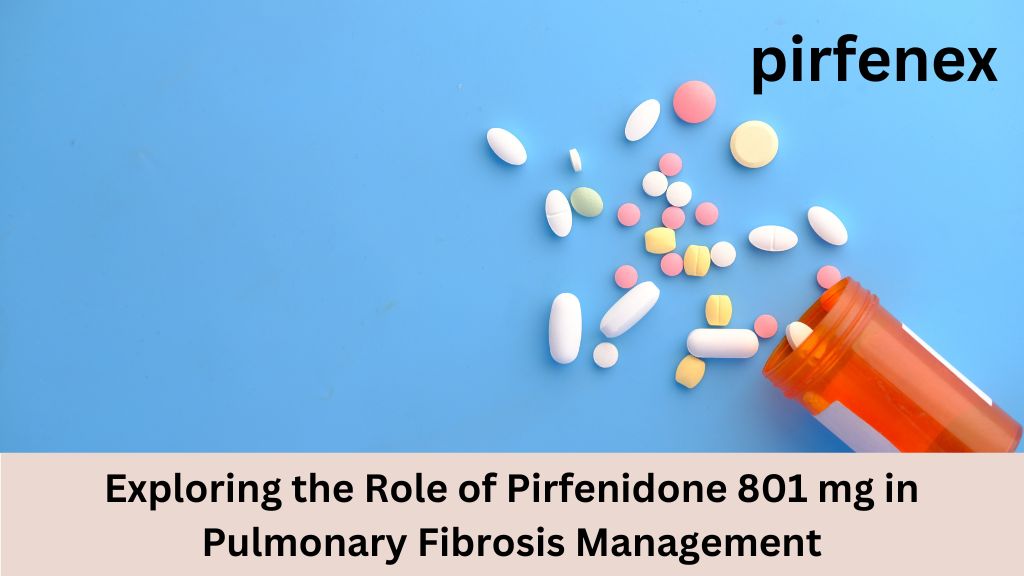
Pulmonary fibrosis is a chronic and progressive lung disease that affects the interstitium, the tissue that supports the air sacs in the lungs. It is characterized by the thickening and scarring of the lung tissue, leading to breathing difficulties and impaired lung function. One promising medication that has shown efficacy in managing pulmonary fibrosis is Pirfenidone 801 mg. In this article, we will explore the role of Pirfenidone 801 mg in the management of pulmonary fibrosis and its potential benefits for patients.
Pulmonary fibrosis is a complex and challenging disease that affects thousands of individuals worldwide. It is crucial to explore effective treatment options that can alleviate symptoms, slow down disease progression, and improve the quality of life for patients. Pirfenidone 801 mg is one such medication that has shown promising results in the management of pulmonary fibrosis.
Pulmonary fibrosis occurs when the lung tissue becomes scarred and thickened over time. This scarring can be caused by various factors, including environmental exposures, autoimmune diseases, and genetic predisposition. As the disease progresses, the lungs lose their ability to expand and contract effectively, leading to shortness of breath, coughing, and fatigue.
Pirfenidone 801 mg is an antifibrotic medication that has been approved for the treatment of idiopathic pulmonary fibrosis (IPF), the most common form of pulmonary fibrosis. It works by reducing the production of fibrotic tissue and slowing down the progression of the disease. Pirfenidone 801 mg has been shown to decrease the decline in lung function and improve exercise tolerance in patients with IPF.
Pirfenidone 801 mg exerts its therapeutic effects through multiple mechanisms of action. It inhibits the production of various pro-inflammatory and fibrotic mediators, such as transforming growth factor-beta (TGF-β) and tumor necrosis factor-alpha (TNF-α). By modulating these pathways, Pirfenidone 801 mg can reduce inflammation and fibrosis in the lungs, preserving lung function.
Numerous clinical studies have demonstrated the efficacy of Pirfenidone 801 mg in the management of pulmonary fibrosis. These studies have shown that treatment with Pirfenidone 801 mg can slow down the decline in lung function, improve exercise capacity, and reduce the risk of acute exacerbations. Patients treated with Pirfenidone 801 mg have reported improved quality of life and a decreased need for supplemental oxygen.
Like any medication, Pirfenidone 801 mg may cause certain side effects. The most common side effects reported include nausea, rash, gastrointestinal disturbances, and fatigue. However, these side effects are generally mild to moderate and can be managed with dose adjustments or supportive care. It is essential for patients to discuss any concerns or side effects with their healthcare provider.
Pirfenidone 801 mg is typically administered orally, in the form of capsules. The recommended dosage is usually divided into three daily doses to be taken with meals. It is crucial for patients to adhere to the prescribed dosage and follow their healthcare provider’s instructions carefully. Regular follow-up visits and monitoring of lung function are essential to assess the response to treatment.
Many patients with pulmonary fibrosis who have been treated with Pirfenidone 801 mg have reported positive experiences and improved quality of life. They have noted reduced breathlessness, increased energy levels, and the ability to engage in daily activities with greater ease. These personal testimonials highlight the potential benefits of Pirfenex 801 mg in managing pulmonary fibrosis.
Pirfenidone 801 mg is one of the few medications approved for the treatment of pulmonary fibrosis. It has shown comparable efficacy to other treatment options, such as nintedanib, another antifibrotic medication. The choice between Pirfenidone 801 mg and other treatment options depends on various factors, including the patient’s specific condition, disease severity, and individual response to therapy.
Research in the field of pulmonary fibrosis is ongoing, with scientists and healthcare professionals striving to improve treatment outcomes and discover new therapeutic options. Ongoing studies are evaluating the long-term effects of Pirfenidone 801 mg, combination therapies, and potential biomarkers that can help predict treatment response. These advancements hold promise for the future management of pulmonary fibrosis.
Pirfenidone 801 mg has emerged as a valuable treatment option for individuals suffering from pulmonary fibrosis. Its ability to slow down disease progression, improve lung function, and enhance the quality of life for patients has made it a key player in the management of this challenging condition. With ongoing research and advancements in the field, the role of Pirfenex 801 mg in pulmonary fibrosis management is expected to expand further.
WhatsApp us